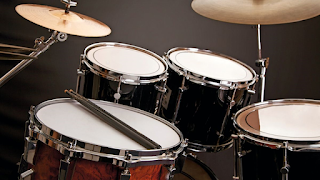Have drums always been your passion? Ready to invest in the real thing? Drums are the heartbeat in any band, providing the rhythm and beat that drives the music. They are the essential foundation for the other instruments, the backbone of many musical genres. But if you are a beginner, choosing your first set of acoustic drums may seem like a complex task. Do you build it piece by piece, buy a pre-assembled kit, a new or a used one,..? If you are looking for a kit for your little percussionist at home, or you have decided to make your childhood dream come true, then here’s a bit of help.
What Do Acoustic Drum Kits Include?
Before you start choosing the hottest-looking set, it’s good to know what the essential bits are, and what accessories can be added on later. A complete drum kit usually includes a bass drum (kick drum), snare drum, tom-toms (two or three), hi-hat cymbals, crash cymbal, ride cymbal, and hardware (stand, pedals, and throne). Many brands, however, offer a more beginner-friendly set-up, a basic or a shell kit. These contain everything a beginner drummer could need without the pieces that can distract the student. For the youngest drummers-to-be, look for Junior sets that are appropriately sized for their age. Kids outgrow these kits quickly, so invest smartly.
- Bass Drum ( Kick Drum): The largest drum in the kit, played with a foot pedal. It gives a deep, punchy sound.
- Snare Drum: The most used drum in many musical styles, essential for creating accents and driving the rhythm. It’s recognisable for its sharp, crisp sound.
- Tom – Toms: They come in different sizes and are used for fills and melodic patterns. A basic kit usually includes a pair of rack toms and a floor tom.
- Cymbals: Hi-hat, crash, and ride cymbal are included in standard sets. They add shimmer, crash, and sizzle to the drum sound.
Choose the Right Size
Acoustic drum kits usually come in two sizes, the ‘Fusion’ and ‘Standard’ or ‘Rock’. What distinguishes the sizes is the shells diameters. So, a fusion kit will typically feature 10 ̎ and 12 ̎ mounted toms, a 14 ̎ floor tom and a 20 ̎ kick drum. Whereas, the rock kit commonly holds a 12 ̎ and 13 ̎ mounted toms, a 16 ̎ floor tom and a 22 ̎ kick drum. A four or five-piece configuration of a high-quality acoustic drum kit offers the best combinations.
Material Matters
Drums are typically made from wood, with popular choices including:
• Maple: Warm, balanced tone with good projection
• Birch: Bright, focused sound with strong attack
• Poplar: Affordable option with a balanced tone
• Mahogany: Rich, dark tone with good low-end
For beginners, poplar or a blend of woods (often found in entry-level kits) can be a good starting point. Once you progress and develop preferences you can pick the material that has the specific tonal characteristics you are looking for.
Cymbals
While drums are the core of your kit, cymbals play a crucial role in shaping your overall sound. Most starter kits come with a basic cymbal pack, which is fine for beginners. However, if your budget allows, consider upgrading to better-quality cymbals. Many popular brands offer cymbal packs designed for beginners that offer good value for money.
Hardware
Don't overlook the importance of sturdy hardware. Your stands, pedals, and throne (drummer's seat) need to be reliable and stable. Look for double-braced stands for added durability. While you don't need top-of-the-line hardware as a beginner, avoid the cheapest options as they may need replacing sooner.
New vs. Used
Buying a new acoustic drum kit ensures you're getting a fresh set with warranty coverage, but don't rule out the used market altogether. You can often find higher-quality kits at lower prices if you're willing to buy second-hand. Just be sure to inspect the drums carefully for any damage or excessive wear.
Try Before You Buy
If possible, visit a music store and try out different kits. Pay attention to how the drums feel, how easily you can reach all the components and the overall sound. Even if you end up buying online, this hands-on experience can be invaluable in making your decision.
Don't Forget the Extras
Before you spend all your savings on the drum set, remember to budget for some essential accessories:
• Drumsticks (start with a versatile pair like 5A)
• Drum key (for tuning)
• Practice pad (for quiet practice sessions)
• Ear protection (crucial for preserving your hearing)
Maintenance and Care
Once you've got your drum kit acoustic, learn how to properly maintain it. Clean it regularly, make sure it’s properly tuned, and replace drumheads when needed. When you are not drumming away, store the kit in a dry, temperature-controlled environment, away from direct sunlight. Taking good care of your drums will ensure they last longer and continue to sound great.
Final Thoughts
Ready to jam? Your first drum set can be your ticket to an exciting musical journey. Take your time, do your research, and choose a kit that feels right. Remember, even a modest kit can sound great in the hands of a skilled drummer, so focus on practicing and developing your skills. Learn new techniques, play with other people, take lessons. As you become more experienced, you can upgrade individual components or eventually invest in a higher-end kit. Most importantly, have fun!







No comments:
Post a Comment